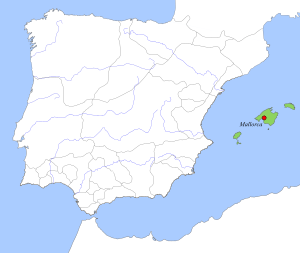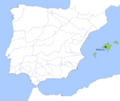1113–1115 Balearic Islands expedition facts for kids
Quick facts for kids 1113–1115 Balearic Islands expedition |
|||||||
|---|---|---|---|---|---|---|---|
| Part of the Crusades | |||||||
 The taifa of the Balearics (green), with its capital (Mallorca), the Crusaders' chief target, indicated. |
|||||||
|
|||||||
| Belligerents | |||||||
| Republic of Pisa Catalan counties County of Provence Giudicato of Torres Papal States |
Taifa of Majorca Almoravids |
||||||
| Commanders and leaders | |||||||
| Pietro Moriconi Ramon Berenguer III of Barcelona Hug II of Empúries Saltaro of Torres |
Abu-l-Rabi Sulayman (POW) Abu al-Mundhir † |
||||||
| Strength | |||||||
| 300 Pisan ships 150 Catalan and Provençal ships |
Unknown | ||||||
| Casualties and losses | |||||||
| Unknown | High | ||||||
In 1114, a big journey was made to the Balearic Islands. At that time, these islands were a Muslim taifa (a small independent kingdom). This journey was part of a Crusade, which was like a holy war supported by the Pope.
The idea for this expedition came from a deal made in 1113 between the Republic of Pisa (a powerful city in Italy) and Ramon Berenguer III, who was the Count of Barcelona. Pope Paschal II gave his full support. Many important leaders from Catalonia and Occitania (a region in France) joined in. People from northern and central Italy, Sardinia, and Corsica also helped.
Some people think the Crusaders were inspired by a Viking king, Sigurd I, who attacked Formentera in 1108 or 1109. The expedition ended in 1115 when the Crusaders took control of the Balearic Islands. However, they only held them for about a year. The main story of this event comes from a book called the Liber maiolichinus, written by people from Pisa around 1125.
Contents
Why the Expedition Happened
For a long time, the Pope had given Pisa special rights over the Balearic Islands. In September 1113, a fleet of ships from Pisa was sailing to Majorca. A storm blew them off course, and they ended up near Blanes in Catalonia. They thought it was the Balearic Islands at first!
In the port of Sant Feliu de Guíxols, the Pisans met with the Count of Barcelona. On September 7, they signed a treaty. This agreement was made to make their "alliance and friendship stronger." The treaty meant that Pisan ships and people would be safe in all lands controlled by the Count of Barcelona. They would not have to pay certain fees or lose their goods if their ships crashed.
The original copy of this treaty is found within another document from 1233. It says that the meeting between Pisa and Barcelona was unplanned and seemed like a gift from God. Some historians wonder if it was truly unplanned, because the Catalans reacted so quickly. They think there might have been some talks before. Saying it was "God's plan" might have made the alliance seem more important and holy.
The treaty itself doesn't directly talk about military plans or attacking Majorca. Maybe that part was agreed upon verbally, or the record was lost. But a Crusade was definitely planned for 1114. The main goals were to free Christian prisoners and stop Muslim pirates who were causing trouble in the seas.
Most of the Pisan fleet went back to Pisa. But some ships, damaged by the storm, stayed behind for repairs. Some men also stayed to build special machines for attacking castles, called siege engines. In the spring of 1114, a new fleet of eighty ships arrived from Pisa. They sailed along the French coast and stopped briefly at Marseille.
Who Joined the Crusade?
The new fleet brought Cardinal Bosone, who was a special messenger from Pope Paschal II. The Pope strongly supported this expedition. He even gave his approval in a special letter called a Papal bull as early as 1113. The Pope also gave the Pisans a "Roman standard, the flag of the apostolic see," which was a very important flag. His calls for people to join the expedition worked!
Besides the 300 ships from Pisa, there were 120 ships from Catalonia and Occitania. A large army also joined. People from Italian cities like Florence, Lucca, Pistoia, Rome, Siena, and Volterra came. Groups from Sardinia and Corsica joined too, led by Saltaro of Torres.
Important Catalan leaders included Ramon Berenguer, Hug II of Empúries, and Ramon Folc II of Cardona. Many powerful lords from Occitania also took part. These included William V of Montpellier with twenty ships, Aimeric II of Narbonne with twenty ships, and Raymond I of Baux with seven ships. Bernard Ato IV, a leader of the Trencavel family, also participated. Ramon Berenguer and his wife, Douce, even borrowed money from the Bishop of Barcelona to help pay for the journey.
Taking and Losing the Islands
The combined Crusader fleet first attacked Ibiza in June. They destroyed its defenses. Ibiza was important because it was located between Majorca and the mainland. If it wasn't taken, it could have been a threat during a siege. The Liber maiolichinus also says that people hiding in caves on Formentera were captured. By August, Ibiza was under Crusader control.
In August 1114, the Crusaders began to surround Palma de Majorca. This was the main city on Majorca. The siege lasted a long time. The counts of Barcelona and Empúries started talking about peace with the Muslim ruler of Majorca. But the cardinal and Pietro Moriconi, the Archbishop of Pisa, stopped these talks. The Catalan rulers probably wanted the Muslims to pay them yearly tribute and stop pirate raids.
Muslim reinforcements arrived from Denia, a port in Spain. These were Almoravids, a powerful group. They surprised a small Pisan fleet of six ships near Ibiza. Only two Pisan ships managed to escape to safety. They found shelter in the remains of a fortress that the Norwegian king had burned down ten years earlier.
In April 1115, the city of Palma finally surrendered. Everyone in the city was enslaved. After this victory, the Crusaders captured most of the other main towns in the Balearic Islands. They also freed most of the Christian prisoners on the islands. The independent Muslim ruler of Majorca was taken back to Pisa as a prisoner. The biggest success, however, was stopping the Majorcan pirates completely.
But the Crusaders' control of the Balearic Islands did not last long. In 1116, the Almoravids from mainland Spain came back and took the islands again.
Images for kids
See also
 In Spanish: Conquista cruzada de Mallorca para niños
In Spanish: Conquista cruzada de Mallorca para niños


